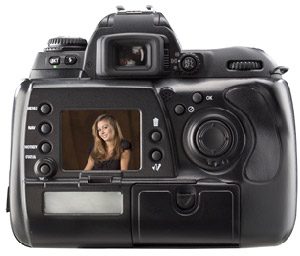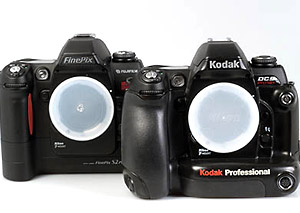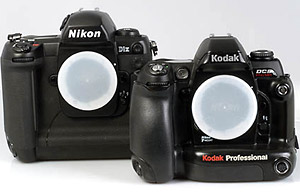|
|
|
The
Leader of the Pack Hands-on
experience I
recently got the opportunity to take a
Kodak Pro 14n to a Texas Hill Country
cattle auction. The
camera was a pleasure to handle, gave
me rich, lifelike color reproduction,
and its full-frame wide angle
capabilities gave me some great
snapshots. (Left)
Kodak DCS Pro 14n photo.
I switched to
ISO 400 inside the auction barn to gain shutter
speed while taking some hand-held available
light snapshots. (No flash allowed.) I was
pleasantly surprised at the reasonably smooth
ISO 400 noise levels, especially considering all
the negative things I'd read in the pro camera
forums about how the camera's upper ISO settings
were pretty rough because of high noise levels.
Auto white balance produced excellent color
accuracy under the flourescent lights.
Holding the
camera at my side with one hand & slowly
pointing it towards my subject, aiming by 'feel'
rather than through the viewfinder gives me
great candid shots. (People don't know that I'm
taking their picture because I don't bring the
camera up to my eye.) This kind of 'scatter
shooting' usually requires some cropping to get
what I'm looking for, and frequently produces
great candid pictures like this interesting
stealth shot of a rancher contemplating the
cattle bidding. (Below) Kodak
DCS Pro 14n ISO 400 photo, Nikkor 20-35mm f2.8
zoom lens, Auto White Balance, Programmed
Automatic Exposure, Raw format, 13.5 megapixel
size setting. The DCS Pro
14n's 13.5 million pixels gave me plenty of room
to crop Remenber - the more pixels a camera has,
the more you can crop and still have enough size
left over to produce a good quality print.
Here's a
screenshot of the crop outline in the original
frame.
Camera
Specifications
Camera
Body Size Comparisons
Frequently
Asked Questions Q.
What is the KODAK PROFESSIONAL DCS Pro 14n
Digital Camera and how does it differ from the
DCS 760? A. The DCS Pro
14n is the latest in six generations of
single-lens-reflex KODAK PROFESSIONAL Digital
Cameras and full digital workflow systems. The
DCS Pro 14n is dramatically different from the
KODAK PROFESSIONAL DCS 760. The Pro 14n is a
feature-rich digital SLR with a new electronics
architecture, new camera body, and a full-size
CMOS image sensor. Q.
What is the difference between the CMOS sensor
and the DCS 760 sensor? A. The DCS 760
uses a traditional CCD image sensor with
6-million-pixel resolution. The DCS Pro 14n uses
the newest professional CMOS sensor technology
available and has 13.9 million pixels. CMOS and
CCD image-sensor technologies are distinctly
different. CCD image sensors are (electron)
charge-coupled devices that require very
sophisticated and power-hungry electronics to
operate, and due to the amount of support
electronics, take up more space and power inside
the camera. CMOS image sensors incorporate
light-sensing technology that allows for charge
conversion right inside the pixel, therefore
dramatically reducing support electronics and
power consumption. The small size of the Pro 14n
camera, even though it incorporates a full 35 mm
area sensor, was achieved through the use of
CMOS sensor technology. Q.
Does the Pro 14n have a NIKON Camera body?
A. Nikon has
custom-manufactured the camera body components
for Kodak Professional. While the DCS Pro 14n
does share features and components with some of
Nikon's own cameras, this particular body is
custom-manufactured for Kodak's use. Kodak
enhanced the body with additional professional
features, such as a vertical "smart" shutter
release, magnesium alloy encasements, and a
10-pin remote release terminal compatible with
most Nikon accessories. Q.
Can Nikon lenses be used with the Pro 14n?
A. Yes. The Pro
14n uses the NIKON F Mount and supports the full
line of current NIKON Lenses. Q.
What other features does the DCS Pro 14n offer?
A. In addition
to the new image sensor, the DCS Pro 14n has a
wide range of professional features that ensure
superior image quality and
performance. Q.
What is variable resolution? A. For the first
time, you can select the resolution you want for
RAW files. Q.
How do you get variable resolution from RAW
files? A. Variable
resolution for RAW files is a unique capability
offered in the Pro 14n. To achieve "true" RAW
status for the lower resolution image files, the
entire 13.9 mp resolution is read off the sensor
at 12 bits dynamic range. Then a proprietary
image-processing algorithm "interpolates and
resamples" the high resolution into a lower
resolution while keeping the 12-bit dynamic
range. The resulting image is specially color
encoded and losslessly compressed to reduce the
file size. This technique achieves very high
quality and low artifacts, while reducing the
native resolution. The powerful DSP engine in
the Pro 14n performs all this processing
in-camera, so users can benefit from more images
per storage card for assignments that do not
require the highest resolution. Q.
Does the DCS Pro 14n use an anti-aliasing
filter? A. No. The DCS
Pro 14n does not have an anti-aliasing filter.
Consequently, the DCS Pro 14n yields images that
are sharper than most other digital SLR cameras.
The resolution of the Pro 14n is so high that
aliasing artifacts are generally not an issue
for most applications. Q.
Who will benefit most from the DCS Pro 14n?
Q.
What is the function of the Basic Mode?
A. The Basic
Mode makes digital photography easy for anyone
who wants to take it out of the box and shoot,
without extensive training or experience.
Q.
What is "Picture Protection?" A. Picture
Protection is included in our entire line of
KODAK PROFESSIONAL DCS Digital Cameras. It
offers a variety of workflow features that
include post-shot exposure compensation, white
balance corrections, file recovery, dual card
storage, and KODAK PROFESSIONAL Extended Range
Imaging Technology (ERI). ERI gives you image
files that work as standard JPEGs but include
the dynamic range and color gamut of raw,
12-bit, DCR camera files. Q.
What is included in the box with the DCS Pro 14n
at purchase? A. The DCS Pro
14n Digital Camera ships with hand strap, neck
strap, body cap, DC Power Module, a custom
rechargeable Li-Ion battery, and charger/AC
Adapter, printed user guide (English),
documentation (localized in 8 languages) on CD,
and localized software CDs for Photo Desk and
Camera Manager, warranty card, and service
information. Q.
Is there an IEEE 1394 cable available for use
with the camera? A. Yes, and it
can be purchased separately. Q.
What is the focal length magnification?
A. Since the DCS
Pro14n has a full 35 mm film size sensor, the
focal length magnification is 1. This means that
35mm lenses operate as they would with film, and
will show the same full image that the lens was
designed to image. Q.
Does the DCS Pro 14n offer an external video
output? A. Yes, user
selectable NTSC and PAL video formats are
supported by the video connection. In NTSC mode,
the color LCD and the video output are enabled
simultaneously. In PAL mode, simultaneous
operation is not supported. Q.
The DCS Pro 14n has a top end ISO of 800, but
the DCS 760 only went to 400. How was this
improvement accomplished? A. The DCS Pro
14n camera is based on a significantly different
sensor and electronics architecture that makes
use of more advanced technology to enable this
top-end ISO improvement. Q.
Are there any plans to market an EOS-mount
version of the DCS Pro 14n? A. Kodak
currently is not publicly discussing any plans
to create a Canon EOS-mount version of the DCS
Pro 14n Digital Camera. Q.
What is Nikon's role in the development of the
DCS Pro 14n? A. Nikon
designed and supplies the lens mount and
photographic body architecture for this camera.
Q.
Are there any plans to market an EOS-mount
version of the DCS Pro 14n? A. Kodak
currently is not publicly discussing any plans
to create a Canon EOS-mount version of the DCS
Pro 14n Digital Camera. Q.
What about camera warranty, service programs?
A. The DCS Pro
14n has a one-year warranty, with service
provided at Kodak Service Centers worldwide.
Various extended warranty programs are available
through Kodak dealers on a country-by-country
basis. Kodak and
Kodak Professional are trademarks of Eastman
Kodak Company.
|

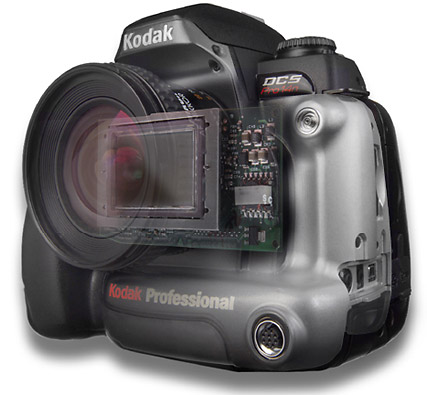
.jpg)
.jpg)
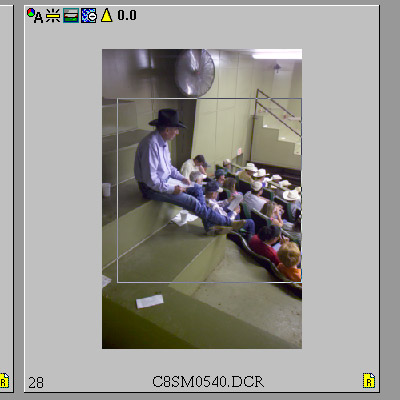
.jpg)
